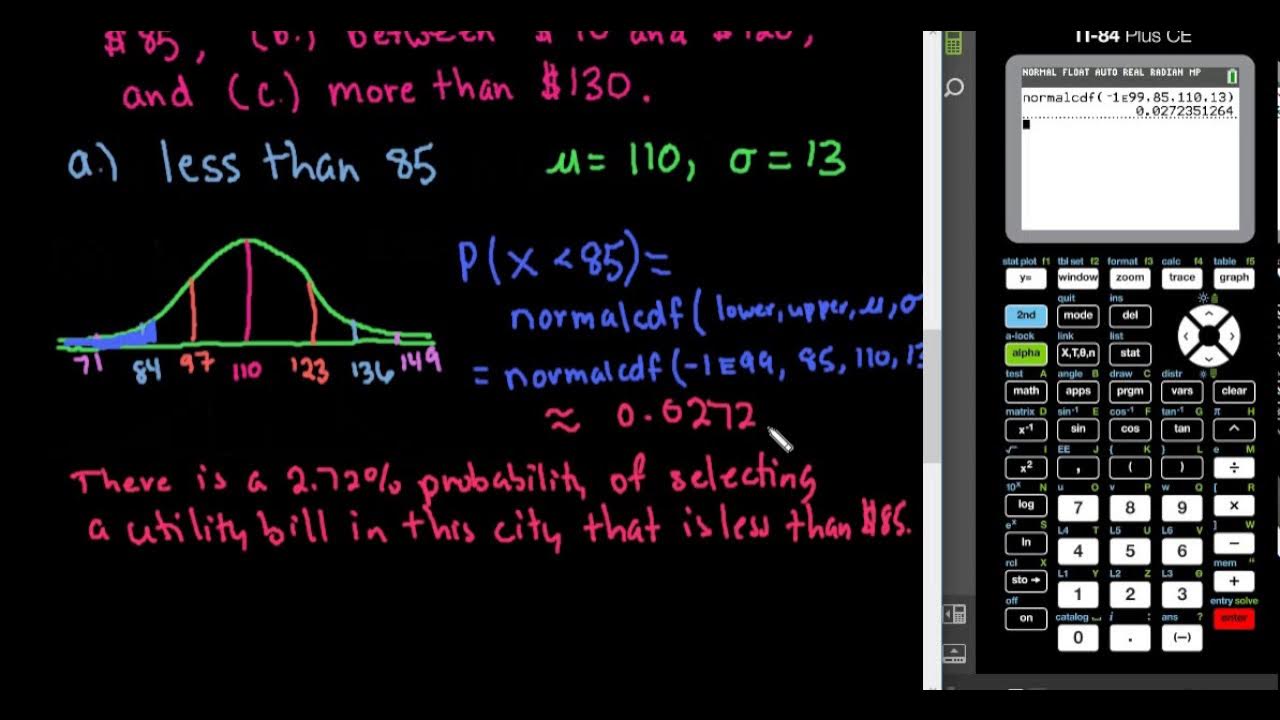Discrete Random Variables
TLDRThis video script explores the concept of discrete random variables, focusing on probability distributions and cumulative functions. It demonstrates how to calculate probabilities for different events and how to determine unknown probabilities by ensuring they sum up to one. The script guides through various examples, including finding the probability of a variable being greater than a certain value, less than another, and calculating cumulative probabilities. It also covers how to derive the value of 'k' in a probability distribution and introduces the cumulative function, illustrating its calculation step by step.
Takeaways
- 📊 Discrete random variables can take on specific values, such as 1, 2, 3, 4, and 5, and their probabilities must sum up to 1.
- 🔍 To find the value of 'k' in a probability distribution, subtract the sum of known probabilities from 1.
- 🔑 The probability of a random variable being greater than a certain value is the sum of the probabilities of all values greater than that threshold.
- 📈 For calculating probabilities of ranges, such as 'greater than 2 but less than or equal to 4', sum the probabilities of the included values.
- 🧩 Each new scenario introduces a different set of values and probabilities, requiring recalculation of unknown probabilities like 'k'.
- 📐 The sum of probabilities for all possible outcomes of a discrete random variable must equal 1, ensuring a complete probability distribution.
- 🤔 To find 'k' when probabilities are given as multiples of 'k', sum all expressions involving 'k' and set them equal to 1 to solve for 'k'.
- 📉 The cumulative distribution function (CDF), denoted as F(x), is the sum of probabilities for all values up to and including a certain point.
- 📝 When constructing a CDF, start with the lowest value and incrementally add the probabilities of subsequent values.
- 📊 The CDF at a specific value x, F(x), represents the probability that the random variable is less than or equal to x.
- 🔚 The final value of the CDF for the highest possible value of x should be 1, indicating the total probability of all outcomes.
Q & A
What is a discrete random variable?
-A discrete random variable is a variable that can take on a countable number of distinct values, such as the integers or a finite set of possibilities.
Why do the probabilities of all mutually exclusive events have to add up to one?
-The probabilities of all mutually exclusive events add up to one because they represent all possible outcomes of a random experiment, ensuring the total probability is 100%.
How do you calculate the value of k when given the probabilities of some outcomes of a discrete random variable?
-You calculate the value of k by ensuring that the sum of all probabilities, including k, equals one. This is done by subtracting the sum of the known probabilities from one and dividing the result by the count of the unknown probabilities.
What is the probability that a discrete random variable X is greater than 2, given the values and their probabilities in the script?
-The probability that X is greater than 2 is the sum of the probabilities of X being 3, 4, or 5, which is 0.1 + 0.3 + 0.3, equaling 0.7.
How do you find the probability that X is between two values, such as greater than 2 but less than or equal to 4?
-You find the probability by summing the probabilities of X being the values within the range, excluding the lower bound and including the upper bound. In this case, it's 0.1 (for X=3) + 0.3 (for X=4), which equals 0.4.
What is the cumulative distribution function (CDF), and how is it used in the context of the script?
-The cumulative distribution function (CDF), denoted as F(x), gives the probability that a random variable X takes a value less than or equal to x. In the script, it is used to add up the probabilities of the random variable X taking on values up to and including certain points.
How do you find the value of k for a discrete random variable with a given probability distribution involving k times the value of x?
-You find the value of k by setting the sum of all probabilities (k times each value of x) to equal one, and then solving for k. In the script, this involves summing the terms k, 2k, 3k, 3k, and 5k and setting the result equal to one, then solving for k, which is found to be 1/14.
What is the probability that a discrete random variable X is less than 2, given the values and their probabilities in the second example of the script?
-The probability that X is less than 2 is the sum of the probabilities of X being 0 or 1, which is 0.3 + 0.1, equaling 0.4.
How do you calculate the probability that a discrete random variable X is greater than a specific value, such as 1.1?
-You calculate the probability by summing the probabilities of X taking on values greater than the specified value. In the script, for X greater than 1.1, it's the sum of the probabilities for X being 2 or 3, which is 0.2 + 0.4, equaling 0.6.
What is the final value of the cumulative distribution function F(x) when all probabilities of a discrete random variable are included?
-The final value of the cumulative distribution function F(x), when all probabilities are included, should be 1, representing 100% probability that the random variable X is less than or equal to the highest value it can take.
Outlines
📊 Understanding Discrete Random Variables and Probability Distribution
This paragraph introduces the concept of discrete random variables, exemplified by a variable 'x' that can take integer values from one to five. It explains the fundamental property that the sum of probabilities of all possible outcomes must equal one. The paragraph demonstrates how to calculate the unknown probability 'k' for the outcomes of four and five by subtracting the sum of known probabilities from one. It also addresses probability questions such as the likelihood of 'x' being greater than two, and the probability of 'x' falling within a specific range, such as greater than two but less than or equal to four. The explanation includes calculating these probabilities by summing the relevant probabilities of the variable's values.
🔍 Calculating Probabilities for Different Discrete Random Variables
The second paragraph continues the discussion on discrete random variables, presenting a scenario with a variable that can take the values of zero, one, two, or three. It outlines the process of determining the remaining probability 'k' to ensure all event probabilities sum to one. The paragraph poses questions regarding the probability of the variable being less than two and greater than 1.1, guiding the viewer through the calculations to find these probabilities. It also introduces a new discrete random variable with a given probability distribution for values one through five and asks to calculate the unknown probability 'k' for the value five, concluding with the complete probability distribution for this variable.
📈 Constructing a Cumulative Probability Distribution Function
The final paragraph shifts the focus to the cumulative probability distribution function, denoted as F(x), for a discrete random variable that can take the values of 1, 2, 3, 4, and 6. It describes a unique scenario where the probabilities are defined as 'k' times the value of 'x', with specific adjustments for x equals 4 and 6. The calculation of 'k' is detailed, ensuring that the total probability equals one. The paragraph then explains how to construct the cumulative distribution by adding the probabilities as 'x' increases, resulting in a step function that represents the sum of probabilities for all values less than or equal to a given point.
Mindmap
Keywords
💡Discrete Random Variable
💡Probability
💡Mutually Exclusive Events
💡Cumulative Function (F(x))
💡Probability Distribution
💡Addition Rule for Probabilities
💡Conditional Probability
💡Normalization
💡Complementary Events
💡K (Constant)
Highlights
Introduction to discrete random variables and how their probabilities must sum to 1.
Calculating the value of k for the probabilities of getting a 4 or 5.
Finding the probability that x is greater than 2 by summing probabilities of x being 3, 4, or 5.
Determining the probability that x is between 2 and 4, excluding 2.
Understanding the requirement for probabilities of mutually exclusive events to add up to 1.
Calculating the probability that x is less than 2 for a different discrete random variable.
Finding the probability that x is greater than 1.1 by considering the probabilities of x being 2 or 3.
Determining the value of k for a probability distribution where probabilities are proportional to the value of x.
Drawing a probability distribution for a discrete random variable with given probabilities for different values of x.
Calculating the cumulative probability function for a discrete random variable.
Adding up probabilities to find the cumulative probability up to and including specific values of x.
Understanding how the cumulative function F(x) is constructed by summing probabilities.
Calculating the cumulative probability for values of x up to and including 1, 2, 3, 4, and 5.
Illustrating the cumulative probability function with specific examples and calculations.
Encouraging viewers to pause the video and try solving the problem before revealing the answer.
Providing a different scenario with a discrete random variable taking values 1, 2, 3, 4, and 6, with probabilities proportional to x.
Finding the value of k for the given probability distribution and redrawing the distribution with the calculated k.
Exploring the cumulative function F(x) for the given probability distribution and calculating specific values.
Summarizing the process of calculating and understanding cumulative probability functions for discrete random variables.
Transcripts
Browse More Related Video

Discrete Random Variables (1 of 3: Expected value & median)

Binomial Distribution in R | R Tutorial 3.1| MarinStatsLectures

Probabilities in a Normal Distribution - TI-84

5.1.2 Discrete Probability Distributions - Probability Distributions and Probability Histograms

Probabilities from density curves | Random variables | AP Statistics | Khan Academy

Math 119 Chap 6 part 2
5.0 / 5 (0 votes)
Thanks for rating: